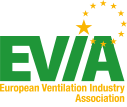European Ventilation Industry Association (EVIA) provides guidance to market on new Ecodesign rules for ventilation units
15/10/2015

Brussels, 15 October 2015 – The European Ventilation Industry Association (EVIA) today releases a comprehensive FAQ on new Ecodesign requirements for ventilation units.
This document is the result of an intensive work carried out by EVIA members, which are representing some of the most important fan and ventilation unit manufacturers in Europe. It is seeking to provide interpretation on a number of elements in the Regulations that have been identified by the industry as needing some further clarification for their proper implementation. It is based on a fair technical understanding of the Regulations.
For a better understanding and more uniform application
This document intends to provide some answers on how the EU Regulations 1253/2014 and 1254/2014, adopted at the end of the last year should be implemented.
This document does not intend to replace the upcoming official European Commission guidance but constitutes EVIA’s contribution to a better understanding of the Regulations and to their more uniform and coherent application across different sectors and product groups.
It is addressed to industry, EU-Commission,Member States, enforcement bodies and others who need to be informed of the provisions.
A necessary guidance for industry
The European Commission, together with the Danish Technology Institute are working on an EU guidance document of which some parts will be released by the end of the year. However, it is still unclear whether all points will be addressed by the entry into force of the new provisions. As the Regulations EU 1253 and 1254/2014 will be enforce 1st January 2016, industry needs clear interpretation at an early stage to provide consistent documentation.
The Regulations EU 1253 and 1254/2014 ensure that newly produced ventilation units,whether they are for residential or non-residential purposes, fulfill minimum energy efficiency requirements as well as maximum noise emission requirements.
The guidance document reflects the state of the art interpretation of the regulation of the involved industry at the time of its drafting, the Guidance offered may be subject to later modification.

